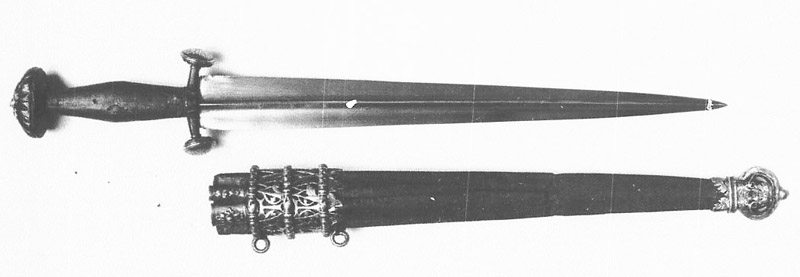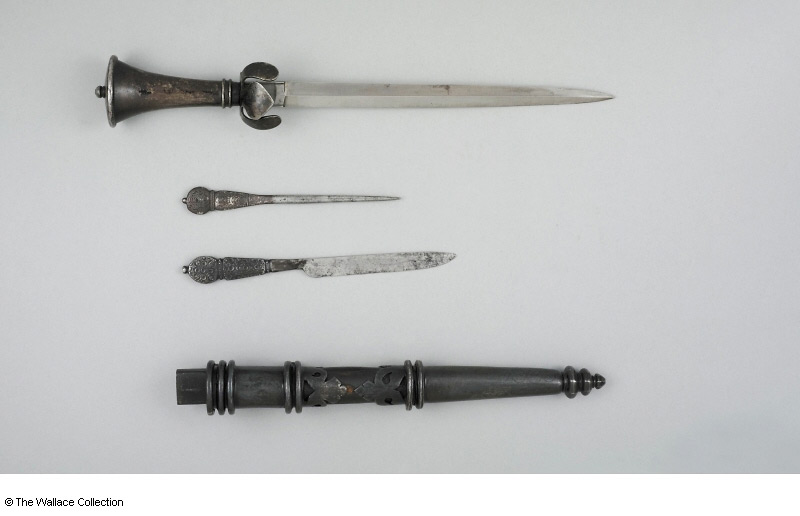| Author |
Message |
|
David G Lawlor
Location: CANADA Joined: 05 Dec 2011
Posts: 7
|
 Posted: Sun 11 Dec, 2011 6:56 pm Post subject: The Classic Landsknecht Dagger? Posted: Sun 11 Dec, 2011 6:56 pm Post subject: The Classic Landsknecht Dagger? |
 |
|
The German mercenary free association Landsknecht were around from the late 1400's to the early 1600's and in that time styles in clothing and weapons continued to slowly change. Victorian reseachers both romanticized and confused modern historians with fancifull and inaccurate notions of what was where and when. The term "Landsknecht dagger" seems to have been applied to every 16th C side knife ever made.
The attached picture is of what is generally known as a Landsknecht dagger. The flared grip is renminiscent of the earlier European ballock dagger, but the scabbard would seen to be unique to the period.
And so my question is this. Just exactly what date was it?
|
|
  |
 |
|
William P
|
 Posted: Sun 11 Dec, 2011 7:52 pm Post subject: Posted: Sun 11 Dec, 2011 7:52 pm Post subject: |
 |
|
sorry, but theres no picture..
i would still be interested to see it
|
|
   |
 |
|
David G Lawlor
Location: CANADA Joined: 05 Dec 2011
Posts: 7
|
 Posted: Mon 12 Dec, 2011 5:46 am Post subject: Classic Landsknecht Dagger Posted: Mon 12 Dec, 2011 5:46 am Post subject: Classic Landsknecht Dagger |
 |
|
Sorry about the "lack of picture" posting. Apparently the image I wanted to use was too large to be transmitted. A brief description. The grip is flared with the wide end at the top like an icecream cone. It is wrapped with cord or wire. The arms of the guard (there are three) droop downwards and the blade is a double edge dagger type.
The scabbard is a tapered cylinder and there are bloused sections on it which I have never seen on any other type of dagger.
|
|
  |
 |
|
Lloyd Winter
Location: Los Angeles Joined: 27 Aug 2011
Posts: 201
|
 Posted: Mon 12 Dec, 2011 8:37 am Post subject: Posted: Mon 12 Dec, 2011 8:37 am Post subject: |
 |
|
Is the dagger you are describing something similar to the 2nd from the top in this pic? I'm at work and don't have access to all my pics so I can't post a pic of the scabbard.
If so it's just a German quillon dagger as far as I know. I've never seen a particular name assigned to this style.
We called them Puff & Slash daggers when I was doing Landsknecht reenactments.
It does seem to be a particularly German style. For a date I'd put them in the first half of the 16th century, but that's just a guess since I've seen very few documented examples.
Jope this is of some help

|
|
  |
 |
|
David G Lawlor
Location: CANADA Joined: 05 Dec 2011
Posts: 7
|
 Posted: Mon 12 Dec, 2011 9:08 am Post subject: Posted: Mon 12 Dec, 2011 9:08 am Post subject: |
 |
|
Thanks Lloyd,
The short answer is yes - it does sort of look like that.
I see it has It has the same sort of flared grip that is on the ballock dagger at the bottom (terrific pictures) from a previous time. It is the scabbard with your "puffed and slashed" sections that is so unique. But I would have guessed the later half of the century.
And perhaps it is not necessarily a Landsknecht dagger as much as just a German military dagger (although what right thinking German lad would not have been in anything but a free-booter company)?
Which also then makes me wonder - is every figure-of-8 quillioned sword a Katzbalger? I have a six foot long Beidenhander with figure-of-8 arms and would guess it was not. So, what length blade - a Katzbalger? Or is it simply that we moderns give precise names to things that folks in the day did not?
|
|
  |
 |
|
Lloyd Winter
Location: Los Angeles Joined: 27 Aug 2011
Posts: 201
|
 Posted: Mon 12 Dec, 2011 9:09 am Post subject: Posted: Mon 12 Dec, 2011 9:09 am Post subject: |
 |
|
"Or is it simply that we moderns give precise names to things that folks in the day did not?"
I think that pretty much nails it down.
|
|
  |
 |
Nathan Robinson
myArmoury Admin


|
 Posted: Mon 12 Dec, 2011 9:52 am Post subject: Posted: Mon 12 Dec, 2011 9:52 am Post subject: |
 |
|
Most forms of what are called Landsknecht daggers are 16th century.
Note what I said in my collection gallery about one that I own:
| Quote: | | Many scholars state that the Landsknecht dagger type may have derived from the rondel dagger, though Ewart Oakeshott noted that it is more likely a distinct form of its own with an equally deliberate design. Regardless, the upper part of the grip of many forms of these daggers is also often a flat disc shape like that of the rondel dagger. Such examples almost always feature a grip that flares upwards towards the pommel and is frequently ribbed horizontally or is spiraled. A variety of guards can be found on the type, more often than not being comprised of flattened lobes flaring out as two leaf-shaped quillons and a larger third acting as a central guard. |
Attached are a variety of Landsknecht daggers from the 16th century.
 Attachment: 56.13 KB Attachment: 56.13 KB

 Attachment: 37.21 KB Attachment: 37.21 KB

 Attachment: 21.86 KB Attachment: 21.86 KB

 Attachment: 19.08 KB Attachment: 19.08 KB

 Attachment: 29.18 KB Attachment: 29.18 KB

 Attachment: 40.97 KB Attachment: 40.97 KB

 Attachment: 20.55 KB Attachment: 20.55 KB

 Attachment: 44.76 KB Attachment: 44.76 KB

 Attachment: 52.75 KB Attachment: 52.75 KB

 Attachment: 61.72 KB Attachment: 61.72 KB

.:. Visit my Collection Gallery :: View my Reading List :: View my Wish List :: See Pages I Like :: Find me on Facebook .:.
|
|
    |
 |
|
David G Lawlor
Location: CANADA Joined: 05 Dec 2011
Posts: 7
|
 Posted: Mon 12 Dec, 2011 4:47 pm Post subject: Posted: Mon 12 Dec, 2011 4:47 pm Post subject: |
 |
|
Thank you Nathan -
The type I was thinking of is shown in your pictures #2, #8, #9 and #10. And it seems that the description you have enlosed also applies to them - a flared grip and three part arms of the guard. The really singular part of the design, though, is in the scabbard accompanying each one.
Jason Grimes in Landsknecht Pikemans Armour to 1550 categories three periods( illustrated by contemporary woodcuts) in which the use of the close open faced sallet or bascinet helmets, and a mail bishops collar (1500-1520) evolved to the use of burgonets (1530 - 1550) and with that a more commonly used breast and back with tassets as the infantry developed its own style of armour. This was paralleled by the most exaggerated form of the puffed and slashed doublet and fighting hose. I'm guessing that the dagger I'm thinking of comes from this later period that was so full of flourish and ornament.
I would also guess that evidence shows that as time went into the later half of the 1500's the development of the peascod doublet and breastplate, and the tightening up of upper body costume generally showed the era of the Landsknecht costume was at an end.
|
|
  |
 |
|
|

